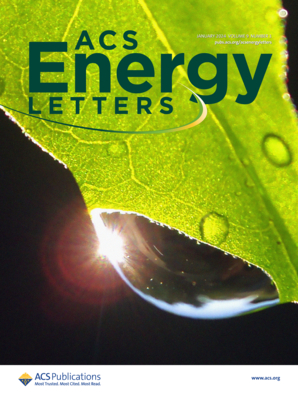Constriction and Contact Impedance of Ceramic Solid Electrolytes
IF 19.3
1区 材料科学
Q1 CHEMISTRY, PHYSICAL
引用次数: 0
Abstract
The development of solid-state batteries (SSBs) is hindered by degradation at solid–solid interfaces due to void formation and contact loss, resulting in increased impedance. We systematically investigate the roles of real and unrecoverable interfacial contact areas at the electrode/Li6PS5Cl interface in driving the impedance rise. By controlling contact geometries and applied pressures, we identify their distinct contributions to the impedance and quantify their influence on the interfacial resistance and transport. Experiments reveal that interfacial resistance follows power law scaling, with exponents of −1 for recoverable contact area and −0.5 to −0.67 for pressure, respectively. Moreover, distributed contacts result in lower impedance due to smaller potential gradients and a more uniform electrical potential distribution. Simulations of the geometries with unrecoverable contact loss predict interfacial resistances in agreement with experiments. Our work highlights the influence of unrecoverable and recoverable contact losses on SSB impedance while quantifying the effectiveness of mitigation strategies.

陶瓷固体电解质的收缩和接触阻抗
固态电池(SSBs)的发展受到由于空洞形成和接触损耗导致的固-固界面退化的阻碍,从而导致阻抗增加。我们系统地研究了电极/Li6PS5Cl界面上真实和不可恢复的界面接触面积在驱动阻抗上升中的作用。通过控制接触几何形状和施加压力,我们确定了它们对阻抗的不同贡献,并量化了它们对界面阻力和传输的影响。实验表明,界面电阻服从幂律缩放,可恢复接触面积指数为- 1,压力指数为- 0.5 ~ - 0.67。此外,分布式触点由于电位梯度较小和电位分布更均匀而导致阻抗更低。具有不可恢复接触损失的几何形状的模拟预测界面电阻与实验结果一致。我们的工作强调了不可恢复和可恢复的接触损耗对SSB阻抗的影响,同时量化了缓解策略的有效性。
本文章由计算机程序翻译,如有差异,请以英文原文为准。
求助全文
约1分钟内获得全文
求助全文
来源期刊

ACS Energy Letters
Energy-Renewable Energy, Sustainability and the Environment
CiteScore
31.20
自引率
5.00%
发文量
469
审稿时长
1 months
期刊介绍:
ACS Energy Letters is a monthly journal that publishes papers reporting new scientific advances in energy research. The journal focuses on topics that are of interest to scientists working in the fundamental and applied sciences. Rapid publication is a central criterion for acceptance, and the journal is known for its quick publication times, with an average of 4-6 weeks from submission to web publication in As Soon As Publishable format.
ACS Energy Letters is ranked as the number one journal in the Web of Science Electrochemistry category. It also ranks within the top 10 journals for Physical Chemistry, Energy & Fuels, and Nanoscience & Nanotechnology.
The journal offers several types of articles, including Letters, Energy Express, Perspectives, Reviews, Editorials, Viewpoints and Energy Focus. Additionally, authors have the option to submit videos that summarize or support the information presented in a Perspective or Review article, which can be highlighted on the journal's website. ACS Energy Letters is abstracted and indexed in Chemical Abstracts Service/SciFinder, EBSCO-summon, PubMed, Web of Science, Scopus and Portico.
 求助内容:
求助内容: 应助结果提醒方式:
应助结果提醒方式:


